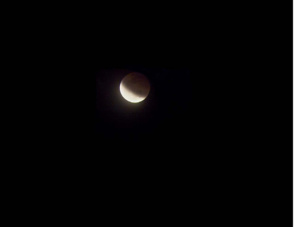
The lunar eclipse of October 27, 2004 as imaged by the author with his 15 cm F/4.2 astrograph. The ruddy red color is clearly apparent.
The longest total lunar eclipse of the 21st century will take place this Friday, July 27. This eclipse is also significant as it takes place during a “Blue” moon, or a full moon that occurs more than once during a calendar month. A lunar eclipse occurs only during the full moon phase as the moon passes through the earth’s shadow.
The total phase of this “blood moon” eclipse will last 1 hour and 43 minutes, during which Earth’s natural satellite will turn a spectacular red or ruddy-brown color, hence the name “Blood Moon”. This ruddy, red color arises from sunlight scattering through earth’s atmosphere.
From start to finish, the entire event will last nearly 4 hours with the time of greatest eclipse at 4:21 p.m. EDT (20:21 GMT). The total eclipse will last from 3:30 p.m. to 5:13 p.m. EDT (19:30 to 21:13 GMT). There will also be some time before and after when the moon is in the lighter part of Earth’s shadow, also known as the penumbra. Including that penumbral time, the eclipse will last 3 hours and 55 minutes.
Unfortunately, the eclipse won’t be visible to viewers in North America, except by webcast. Observers in Europe, much of Africa, the Middle East, southern Asia and the Indian Ocean region will get an eyeful, given cooperative weather.
Additionally, the moon will be at a farther point from Earth in its orbit. This means the moon will appear slightly smaller in the sky and will take a little longer to go through Earth’s shadow, hence one of the reasons for the longer duration of the eclipse.

The lunar eclipse of October 27, 2004 just prior to mid eclipse where the moon is totally immersed in the earth’s shadow. Image credit: the author, 15 cm F/4.2 astrograph.
So, what else controls the duration of the lunar eclipse, you might ask. It is the position of the moon as it passes through the Earth’s shadow. The darkest part of Earth’s shadow, called the umbra, is what we see as the earth’s shadow moving across the moon. You can picture the umbra as a cone extending from Earth in the opposite direction to the sun.
Occurring concurrently on this day but completely unrelated, is Earth’s closest approach to Mars or Mars at opposition, something that occurs approximately every two years. You may have recently noticed brilliant Mars in the east, rising during the late evening.
 Featured image: the full moon during the March 3, 2007 lunar eclipse as imaged by the author with his 15 cm F/4.2 astrograph.
Featured image: the full moon during the March 3, 2007 lunar eclipse as imaged by the author with his 15 cm F/4.2 astrograph.


I know this web page provides quality based content and additional data,
is there any other website which gives these things in quality?